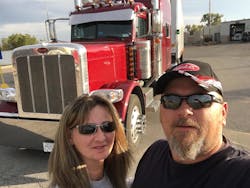(Editor's note: All interviews with deaf drivers or those with hearing loss were conducted by email.)
Truck driver William Newman was dead set against deaf drivers being on the road. Based on his 30 years of experience, he didn't see how they could do the job safely.
"It started when I read an article about [advocacy group] Deaf Truckers United (DTU), and I was 100 percent against it. I was argumentative with them (on social media sites). I just thought it was crazy, ridiculous. I got to talking to some of the deaf people, asking questions, and every time I asked them a question – like how do you hear ambulances, how do you do this, how do you do that and each time they had a legitimate answer."
To bolster his position, Newman tried an experiment. "I bought the most-expensive earplugs I could buy, and I put them in that morning. I turned my telephone off. I turned my stereo off. I turned my CB off, and I did everything possible to make myself deaf."
He was startled by the results. "I actually found myself to be safer. I slowed down; I drove slower than usual. I made less lane changes than usual. I watched my gauges more than usual. Because I couldn’t hear I was looking for other ways to make sure everything was okay. At the end of the day, I just felt like I was a whole lot safer than during my normal day."
All too often, deaf drivers and those with hearing loss, have to argue their way across the country. It's not as bad as it once was, long-time deaf drivers say, but their challenges still are more about ignorant, ill-informed or closed-minded people than the normal road dangers.
Scott Friede has been driving for 15 years, and runs a reefer primarily from Los Angeles to New York City. "I was born deaf, wore hearing aids all my life," he wrote in an email. "I grew up communicating in ASL, American Sign Language."
Before the hearing waiver came out in 2013, Friede had to argue with physicians who administered his DOT physicals that the hearing regulation's requirement to hear a 'forced-whisper sound' means being able to hear any sound. Not just words. "The physicians always expected me to repeat the word they said. Instead, I raised my hand, indicating that I heard a sound. I also had to provide a copy of my audiometric test, updated every two years. The test reports showed an average of 36-38 decibels, just shy of the 40 decibel level as shown in the regulation book."
With the waiver program, he immediately applied and was granted a waiver. "Ever since, I've never had to argue with the doctor or provide a copy of hearing tests. It's peace of mind."
FMCSA officials say that the agency has issued 452 hearing waivers since 2013.
"My worst challenge is dealing with weigh stations that are not equipped with red/green light signals or digital message boards. When I come in to verify with the weighmaster, it would either be a thumbs-up, good to go, or it ends up being a full-blown driver/vehicle inspection, just because they don't think deaf truckers are legal, in my opinion."
One time, he entered a weigh station on U.S. 30 south of Rochelle, Illinois. There were no lights. He drove on the scale and the loudspeaker went off. "As usual, I started to pull to the next group of axles, after the steers were on the platform first. A military-looking guy came storming out of the building, shouting 'what the hell are you doing operating a commercial vehicle, if you don't know how to listen to commands?' I said, "I'm deaf and I can't understand speech on the loudspeaker. 'Get the hell out of my weigh station!' he said, raising his arm, and pointing his finger outwards. Of course I sped off."
Another time, an inspector insisted that Friede should be able to perfectly understand speech with his hearing aids even though it is not required. "Then he told me to bring in all my paperwork, resulting in a driver/vehicle inspection, just because he didn't think I can find broken stuff on my truck especially when I'm hauling oversized. (Friede had oversize permits.) I passed with flying colors."
He adds: "Of course there have been many other times where I've come in the weigh station, and the officers were very understanding and accommodating to my communication needs without any problems. "The best weigh station experience I had was in Winterhaven, California. He told me that my logbook was immaculate and I had nice handwriting."
As far as shippers and receivers, that's not a problem," notes Friede. "I've always had my information filled out on my phone and I just show it to them."
Jerry Jones was the first deaf driver hired by Covenant Transport. "They wrote an article about me in their company quarterly newsletter," he writes. He no longer works for them but for Reynolds Nationwide where he hauls a dairy tanker.
Being Covenant's first deaf driver was challenging, he recalls. "For instance, dispatchers over phone calls, intercoms at gates, weigh stations, everything related to sound. It's mute or static sounds most of the time for us with hearing aids/cochlear processors. We use Qualcomm to communicate with the dispatchers and when there's an emergency, we use Video Relay Services with our cell phones. When it comes to the weigh stations, we rely on the EZ pass lights. It has two colors, green is good to go, red, pull over to the station, simple task to do, but if there is an intercom we tell the DOT officer that we are deaf and pull into the parking. They check the logbook, the standard routine. With the Cat Scale, there's a smartphone app to use ahead of time, so there's much less hassle."
Training
While being on the road presents challenges, deaf and those with hearing loss face roadblocks even before they even get behind the wheel. Finding a school able to accommodate a deaf driver can be difficult.
Suzie Helgerson had ridden part time with her trucker husband, and after their youngest child graduated from high school she spent more time in the cab. Eventually, she decided to get her CDL. "Currently, my husband David is the vice-president of DTU and I'm the secretary. Seeing that we have helped so many to obtain their CDLs, and my children are grown, I decided to try for mine, not just to show that deaf people can do it, but to help support the budget at home and lessen the burden on my husband."
After receiving her waiver, she learned that Fox Valley Technical College in Appleton, Wisconsin offered accommodations for deaf students drivers. Once there, she had to make sure there were interpreters so she could understand what was being taught.
"For the CDL testing, I wasn't allowed an interpreter, and they did allow my instructor, Jake Steinbrink, only for the pretrip and backing. On the road test itself it was the CDL examiner and me. He used flash cards showing me where to go or do. It all worked out."
She adds: "I'm aware that there are a lot of questions about deaf being safe drivers. I believe we are safe. We look in our mirrors more often, and we don't listen to radios or talk on CBs. At railroad crossings, I stop and look in both directions and watch for the lights and gates. When we see the lights of ambulances, police, fire trucks, we pull to the side… right now, I'm team driving with my husband for a small company, based in Illinois. It's all about chasing your dreams and not letting others put you down. When it comes to deafness, it's all about your skills, and not about hearing."
Rob Behnke, Department Chair and Instructor at Fox Valley Technical College, says the school had to specially prepare for Helgerson, their first deaf student driver. "Initially, she sent me an e-mail inquiring about the program, and I had no idea that she was deaf. She explained the waiver system that she was going through with FMCSA, made sure that she crossed all the t's and dotted all the I's, and we were able to sign her up for the program started in June of 2016. She graduated on September 15th."
Says Behnke: We were able to have interpreters and we had other resources and materials for students, some of which were videos, so we had to make sure everything was closed captioned. The team here put this all together with the help of Suzie. As she was going through the program, she would highlight and indicate some areas that she needed help, and we sent the team in and got things transitioned for her."
The team established particular signs for stop, right, left and emergency situations because using regular ASL might be distracting. "If something was approaching that she wasn't aware of, there were certain signs that we had created for her to be alerted and stay in control of the vehicle," he says.
At Action Career Training in Big Spring, Texas, lead instructor Don Olds has been teaching deaf student drivers for about three years (driver Jerry Jones was in the program) and hearing-able students for another three-and-a-half years before that. He has noticed little difference in the mixed classes although he sometimes sees the deaf students scoring a little higher. "I've had several mixed classes with deaf and hearing. It turns into a competition between the students just like any other class. A lot of times the deaf were actually scoring a little bit higher than the hearing."
Why? "They have less distractions; they have to focus more," says Olds. "They also may want it more because it’s a new opportunity, so they’re actually trying harder."
He started taking sign language lessons about two years ago. "It’s fun. It’s challenging. At age 44 learning a new language is not something I planned on doing. It’s an interactive language; it’s a 3D language… and I'm getting older, so I know my hearing’s going to go down. I might as well learn to communicate this way."
Olds not only brings his signing skills but his experience of driving since 1996. "I think they should do away with the hearing requirements. It's an old rule, and I understand why they had it years ago. You had to be able to hear. We had to call in using pay phones. Now with advances in technology, hearing is not necessary. You don’t need it to drive."
As for trucker Newman who shut off his hearing to try to understand what deaf drivers experience, the experiment left a lasting impression. "I'm more open minded now about people in a lot of cases where before I wouldn't have been."
About the Author

Larry Kahaner
Larry Kahaner is an author, journalist, and former FleetOwner contributor.
